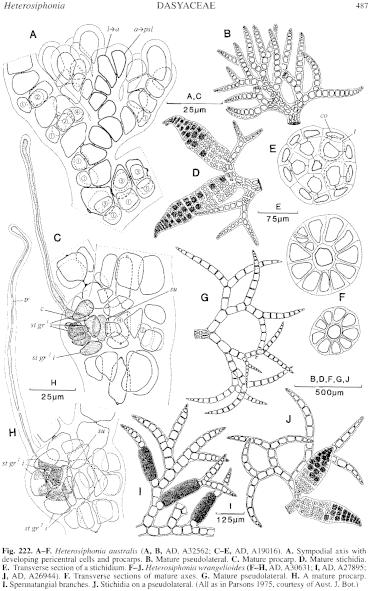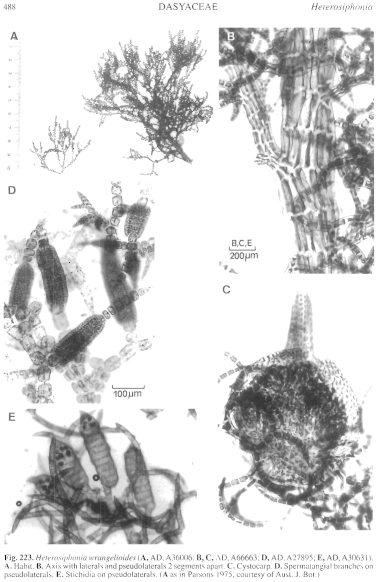|
|
|
|
|
|||||||||||
|
Electronic Flora of South Australia Species Fact Sheet
Phylum Rhodophyta – Order Ceramiales – Family Dasyaceae
Selected citations: De Toni 1903: 1223. Falkenberg 1901: 647, 716. Huisman & Walker 1990: 428. Lucas 1912: 158; 1929b: 52. Lucas & Perrin 1947: 317. May 1965: 381. Parsons 1975: 612, figs 15, 16, 49B. Silva et al. 1996: 443.
Synonyms
Dasya wrangelioides Harvey 1855a: 542; 1860, p1. 174; 1863, synop.: xxiii. J. Agardh 1863: 1192; 1890a: 86. Kützing 1864: 28, pl. 79a, b. Sonder 1881: 36. Tepper 1883: 66. Wilson 1892: 165.
Baillouviana wrangelioides (Harvey) Kuntze 1891: 885.
Dasya guichensis Reinbold 1897: 57.
Heterosiphonia guichensis (Reinbold) De Toni 1903: 1234. Lucas 1912: 159; 1929b: 52. Lucas & Perrin 1947: 318. May 1965: 382.
Thallus (Fig. 223A) medium to dark red, with numerous erect ecorticate axes (Fig. 223B) 6–12 cm high and (200–) 300–700 µm in diameter, arising from prostrate axes. Attachment by rhizoids from prostrate axes; epiphytic usually on Amphibolis (and coralline algae?). Structure. Apices of axes sympodial and alternately distichous, developing 8–9 (–11) pericentral cells (Fig. 222F) beginning 10–12 segments from the apex, cut off in alternating sequence. Pseudo] aterals 2 segments apart (Fig. 223B), 0.7–1.5 (–2) mm long, each with 3–5 subdichotomies (Fig. 222G), cells 40–75 µm in diameter and L/D 0.8–2, tapering slightly to the last 2–3 cells of the acute apices, branches divergent, basal segments becoming polysiphonous. Rhizoids developed on modified pseudolaterals on prostrate axes. Rhodoplasts discoid, elongate or chained in larger cells.
Reproduction: Gametophytes dioecious. Procarps (Fig. 222H) formed on lower cells of pseudolaterals which develop 5 pericentral cells, the fifth bearing a carpogonial branch and 2
Type from Fremantle, W. Aust. (Harvey); lectotype Harvey, Alg. Aust. Exsicc. 207A, in Herb. Harvey, TCD.
Selected specimens: Safety Bay, W. Aust., drift (Womersley, 18.viii.1979; AD, A50778). Head of Great Australian Bight, S. Aust., on Amphibolis, drift (Parsons, 4.xi.1968; AD, A32948). Elliston, S. Aust., on Amphibolis, drift (Parsons, 23. viii.1967; AD, A31890). Stenhouse Bay, Yorke Pen., S. Aust., on Amphibolis, drift (Womersley, 9.iv.1950; AD, A13227). Tiparra Reef, S. Aust., on Amphibolis, 12 m deep (Shepherd, 27.vii.1970; AD, A36006). Aldinga, S. Aust., on Amphibolis, drift (Womersley, 29.vii.1966; AD, A30631). Port Elliot, S. Aust., on Amphibolis, drift (Ricci, 26.ix.1996; AD, A66663). Vivonne Bay, Kangaroo I., S. Aust., on Amphibolis, 2–6 m deep (Mitchell, 21.viii.1963; AD, A26944). Kingston, S. Aust., on Scaberia, drift (Womersley, 20.v.1964; AD, A27895). Robe, S. Aust., on Amphibolis, 2 m deep (Kildea, 25.x.1996; AD, A67095). Port MacDonnell, S. Aust., on Amphibolis, drift (Womersley, 29.ix.1996; AD, A66674). Double Corner Bay, Portland, Vic., on Amphibolis, drift (Beauglehole, 14.vii.1951; AD, A21641). Port Phillip Heads, Vic., drift (Sinkora A1152, 8–12.xi.1970; AD, A54213). Walkerville, Vic., on Amphibolis, drift (Sinkora A2612, 16.xi.1979; AD, A61034). Low Head, Tas., drift (Cribb 74.11, 16.ix.1950; AD, A16282).
Distribution: Fremantle and Rottnest I., W. Aust., to Walkerville, Vic., and N Tasmania.
Taxonomic notes: sterile groups, with pericentral cells forming 7–10 pericarp initials. Post-fertilization (with a connecting cell), the auxiliary cell, central cell, sterile pericentral cells and lower gonimoblast cells contribute to the fusion cell, with the much branched gonimoblast bearing rows of ovoid carposporangia 16–35 µm in diameter. Cystocarps (Fig. 223C) urceolate, 0.7–1.2 mm in basal diameter, with a tapering to flared neck of similar length, borne on a short polysiphonous stalk. Spermatangial branches (Figs 222 I, 223D) occur as ultimate branches of pseudolaterals, with a basal cell and terminal simple or branched row of 6–8 sterile cells, cylindrical, (100–) 150–300 (–400) µm long and 60–80 in diameter; axial cells with 4 pericentral cells, dividing to form several initials each producing 4–5 spermatangia in the outer layer.
Tetrasporangial stichidia (Figs 222J, 223E) occur on lower cells of the pseudolaterals, sessile and usually on polysiphonous stalks, lanceoid, 400–700 µm long and 160–200 (–240) }.tm in diameter, with 10–20 fertile segments; each segment with 5–6 pericentral cells, all usually producing tetrasporangia 35–55 µm in diameter, each with 2 divided cover cells covering the sporangia.
H. wrangelioides is mainly epiphytic on Amphibolis (usually A. antarctica).
References:
AGARDH, J.G. (1863). Species Genera et Ordines Algarum. Vol. 2, Part 3, pp. 787–1291. (Gleerup: Lund.)
AGARDH, J.G. (1890a). Till algernes systematik. Acta Univ. lund. 26(3), 1–125, Plates 1–3.
DE TONI, G.B. (1903). Sylloge Algarum omnium hucusque Cognitarum. Vol. 4. Florideae. Sect. 3, pp. 775–1521 + 1523–1525. (Padua.)
FALKENBERG, P. (1901). Die Rhodomelaceen des Golfes von Neapel und der angrenzenden Meeres-abschnitte. Fauna und Flora des Golfes von Neapel. Monogr. 26. (Friedlander: Berlin.)
HARVEY, W.H. (1855a). Some account of the marine botany of the colony of Western Australia. Trans. R. Jr. Acad. 22, 525–566.
HARVEY, W.H. (1860). Phycologia Australica. Vol. 3, Plates 121–180. (Reeve: London.)
HARVEY, W.H. (1863). Phycologia Australica. Vol. 5, Plates 241–300, synop., pp. i-lxxiii. (Reeve: London.)
HUISMAN, J.M. & WALKER, D.I. (1990). A catalogue of the marine plants of Rottnest Island, Western Australia, with notes on their distribution and biogeography. Kingia 1, 349–459.
KÜTZING, F.T. (1864). Tabulae Phycologicae. Vol. 14. (Nordhausen.)
KUNTZE, O. (1891). Revisio generum Plantarum. Part II. 4. Algae, pp. 877–930. (Leipzig.)
LUCAS, A.H.S. & PERRIN, F. (1947). The Seaweeds of South Australia. Part 2. The Red Seaweeds. (Govt Printer: Adelaide.)
LUCAS, A.H.S. (1912). Supplementary list of the marine algae of Australia. Proc. Linn. Soc. N.S.W. 37, 157–171.
LUCAS, A.H.S. (1929b). A census of the marine algae of South Australia. Trans. R. Soc. S. Aust. 53, 45–53.
MAY, V. (1965). A census and key to the species of Rhodophyceae (red algae) recorded from Australia. Contr. N.S.W. natn. Herb. 3, 349–429.
PARSONS, M.J. (1975). Morphology and taxonomy of the Dasyaceae and Lophothalieae (Rhodomelaceae) of the Rhodophyta. Aust. J. Bot. 23(4), 549–713.
REINBOLD, T. (1897). Die Algen der Lacepede und Guichen Bay und deren näherer Umgebung (Süd Australien), gesammelt von Dr. A. Engelhart-Kingston. Nuova Notarisia 8, 41–62.
REINBOLD, T. (1899). Meeresalgen von Investigator Street (Slid Australien), gesammelt von Miss Nellie Davey (Waltham, Honiton). Hedwigia 38, 39–51.
SILVA, P.C., BASSON, P.W. & MOE, R.L. (1996). Catalogue of the Benthic Marine Algae of the Indian Ocean. (University of California Press: Berkeley, Los Angeles & London.)
SONDER, O.W. (1881). In Mueller, F., Fragmenta Phytographiae Australiae. Supplementum ad volumen undecinum: Algae Australianae hactenus cognitae, pp. 1–42, 105–107. (Melbourne.)
TEPPER, J.G.O. (1883). Botanical notes relating to South Australia. Trans. R. Soc. S. Aust. 6, 65–67.
WILSON, J.B. (1892). Catalogue of algae collected at or near Port Phillip Heads and Western Port. Proc. R. Soc. Vict. 4, 157–190.
The Marine Benthic Flora of Southern Australia Part IIIC complete list of references.
Publication:
Womersley, H.B.S. (24 December, 1998)
The Marine Benthic Flora of Southern Australia
Rhodophyta. Part IIIC. Ceramiales – Ceramiaceae, Dasyaceae
©State Herbarium of South Australia, Government of South Australia
Illustrations in Womersley Part IIIA, 1998: FIGS 222 F–J, 223.

Figure 222 enlarge
Fig. 222. A–F. Heterosiphonia australis (A, B, AD, A32562; C–E, AD, A19016). A. Sympodial axis with developing pericentral cells and procarps. B. Mature pseudolateral. C. Mature procarp. D. Mature stichidia. E. Transverse section of a stichidium. F–J. Heterosiphonia wrangelioides (F–H, AD, A30631; I, AD, A27895; J, AD, A26944). F. Transverse sections of mature axes. G. Mature pseudolateral. H. A mature procarp. I. Spermatangial branches. J. Stichidia on a pseudolateral. (All as in Parsons 1975, courtesy of Aust. J. Bot.)

Figure 223 enlarge
Fig. 223. Heterosiphonia wrangelioides (A, AD, A36006; B, C, AD, A66663; D, AD, A27895; E, AD, A30631). A. Habit. B. Axis with laterals and pseudolaterals 2 segments apart. C. Cystocarp. D. Spermatangial branches on pseudolaterals. E. Stichidia on pseudolaterals. (A as in Parsons 1975, courtesy of Aust. J. Bot.)

|
Email Contact: State Herbarium of South Australia |

|